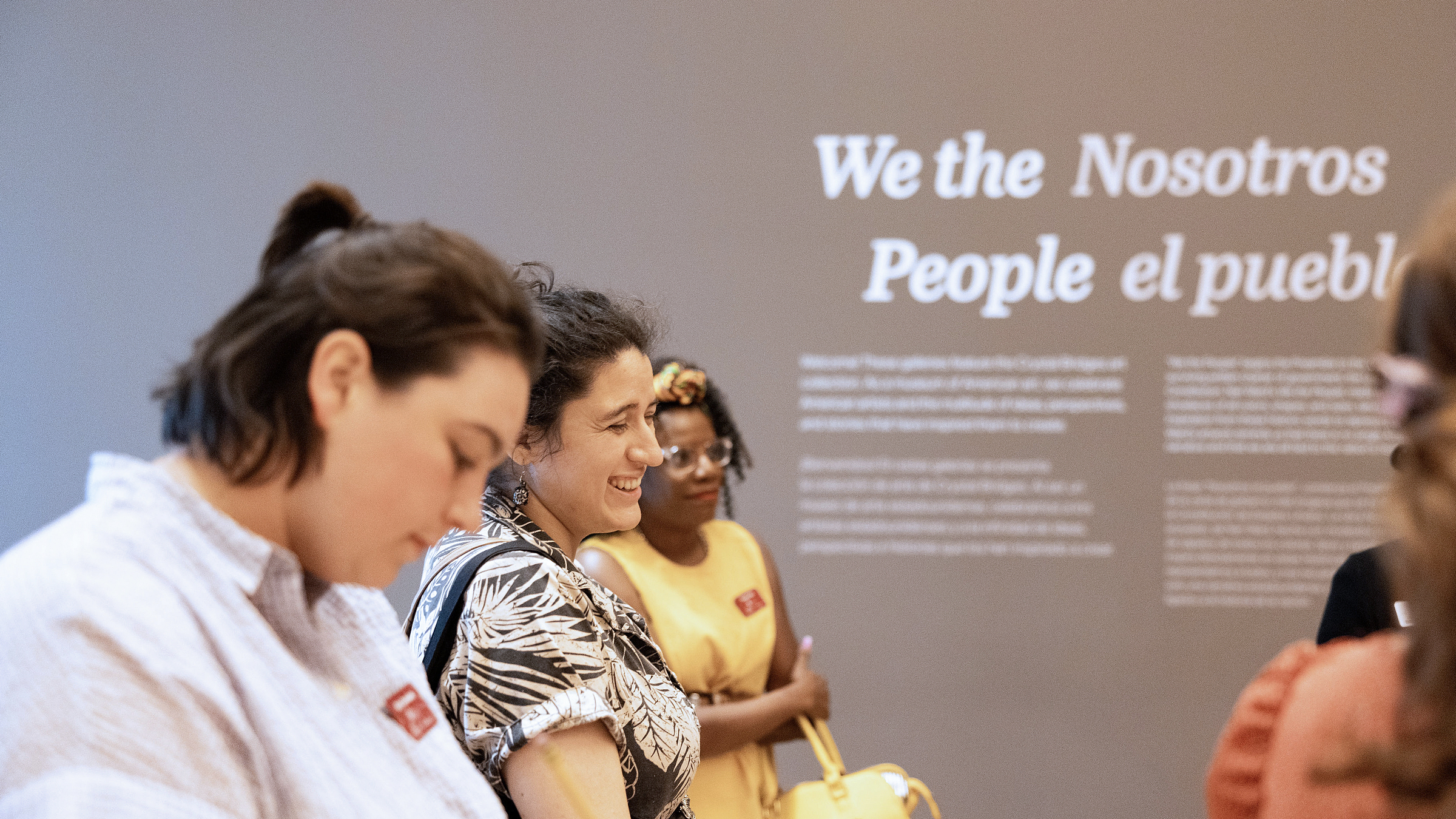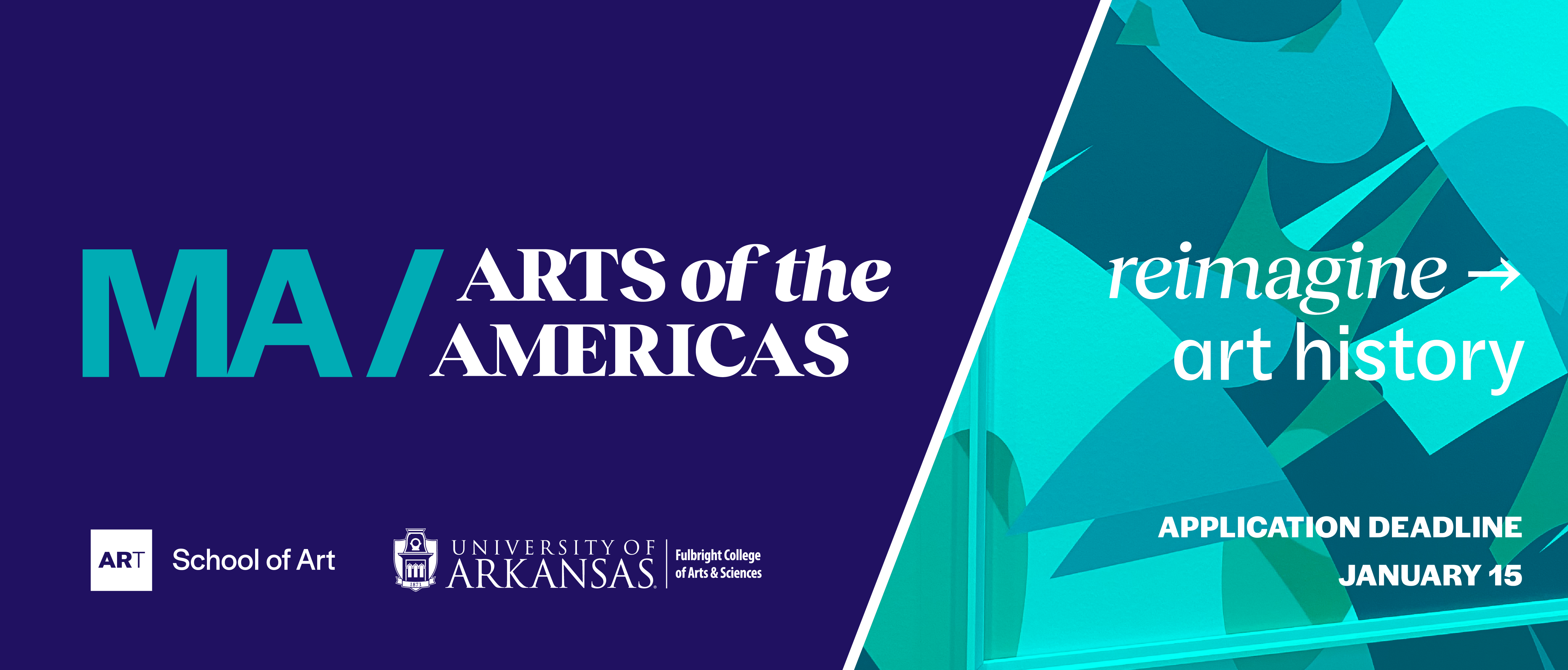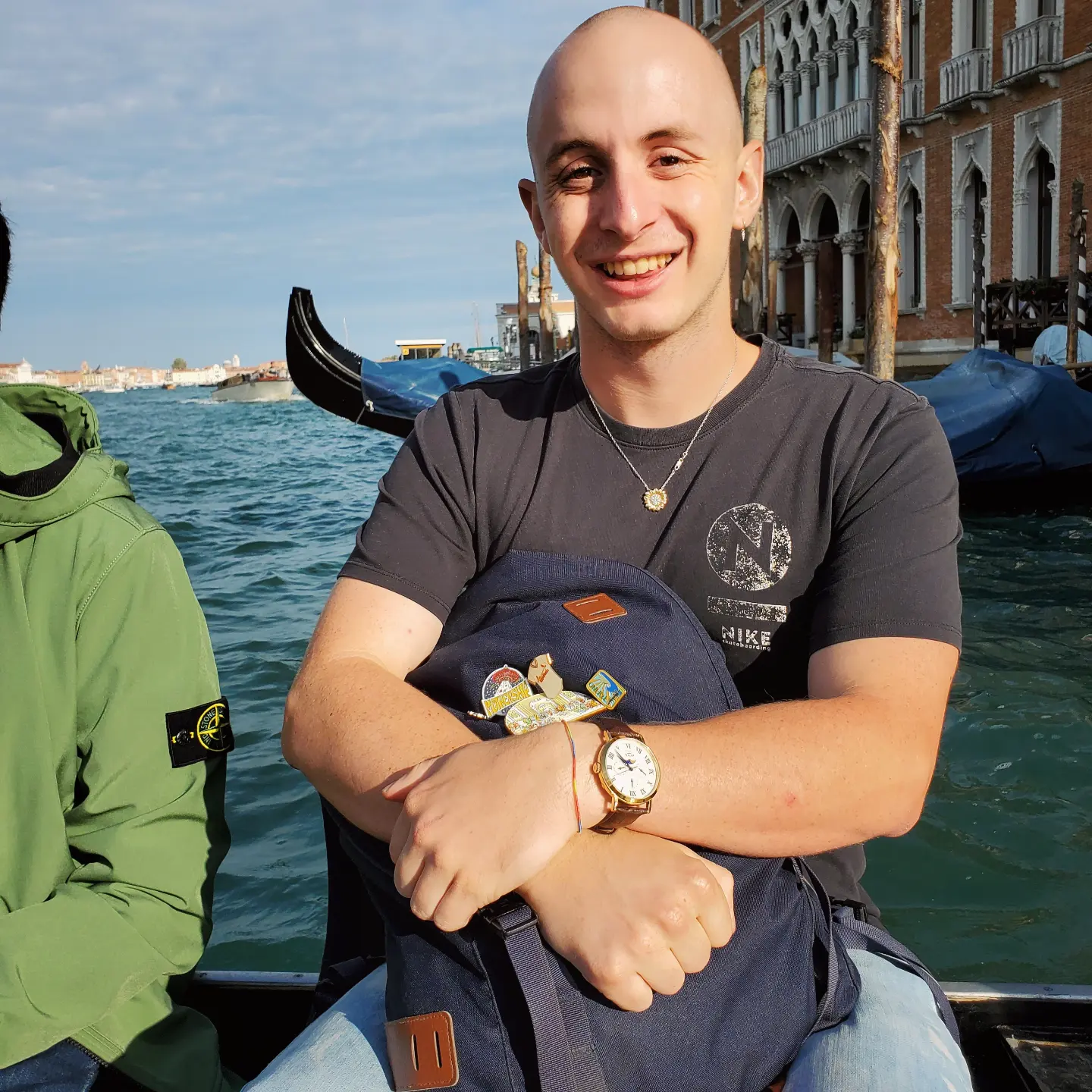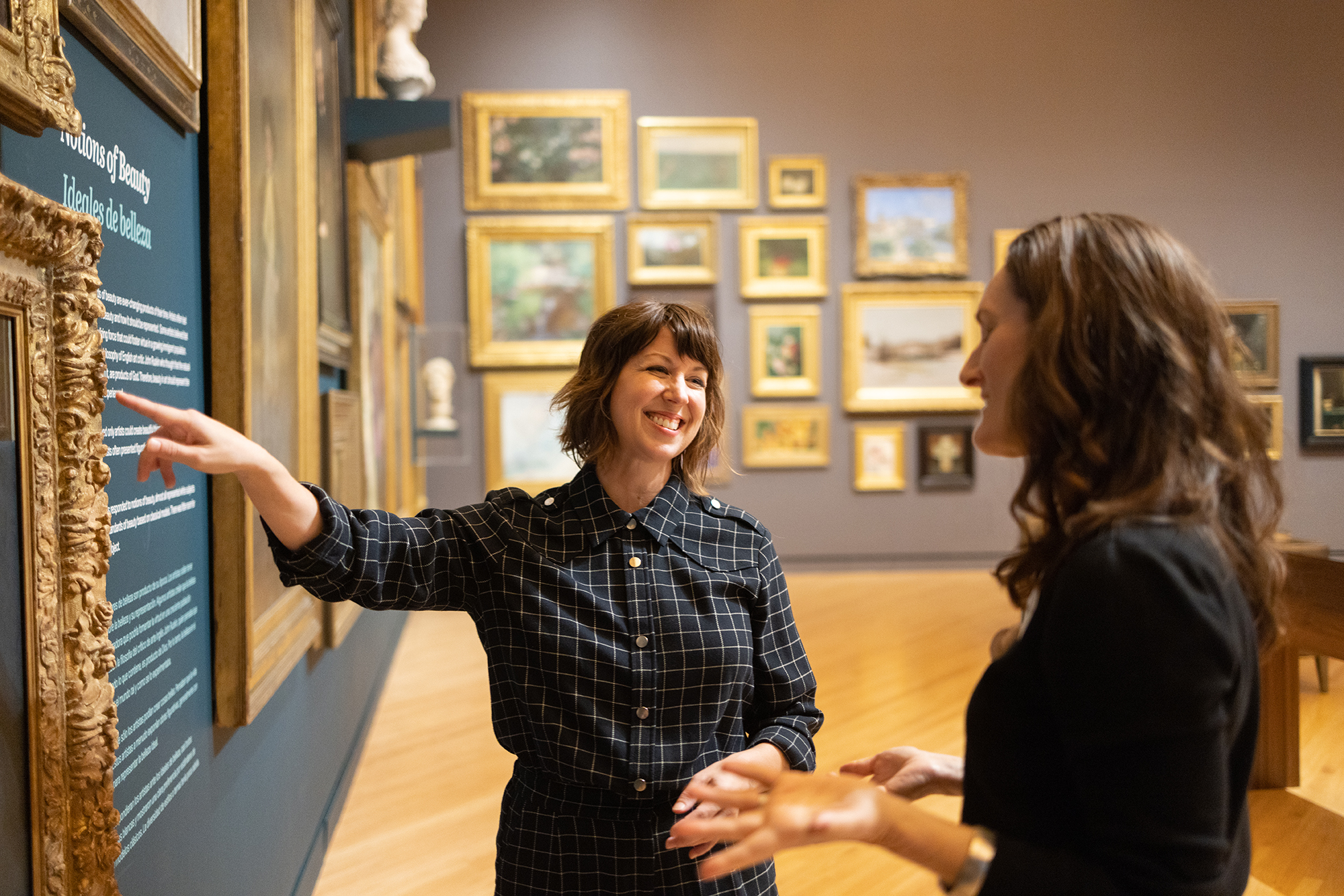The School of Art is thrilled to launch the new Master of Arts in Art History specializing in the Arts of the Americas in partnership with Crystal Bridges Museum of American Art. Come study with us and declare what art history can be.
Overview
The Art History M.A. degree is an accredited two-year residency program in partnership with Crystal Bridges Museum of American Art and specializing in the arts of the Americas.
Educating students in a multivocal and inclusive art history, the program aims to give students the interdisciplinary training and robust work experiences that they will need to thrive with an M.A. degree in industries that value visual literacy, creativity, communication, collaboration, and research. The program prepares students for top Ph.D. programs in art history, but also facilitates other trajectories for those seeking to contribute to the arts and society with an M.A. degree.
Thanks to the transformational gift from the Walton Family Charitable Support Foundation, all graduate students accepted into the program will receive funding support during the two years of study.
Please direct specific questions about the M.A. program to Jennifer Greenhill, greenhil@uark.edu,Endowed Professor and Graduate Director.
Funding
Thanks to the generous gift from the Walton Family Charitable Support Foundation, students in the M.A. art history program receive tuition waivers and opportunities for additional funding support through graduate assistantships, fellowships, and research and travel grants.
|
Graduate school is challenging enough; being able to dedicate myself completely to following my curiosities and academic passions without fear of making ends meet has been a gift beyond measure." Alex Betz '25 |
How to Apply
The School of Art application is free and submitted through Slideroom, a web-based portfolio and document submission system.
The program will accept applications for the 2026-27 academic year in January 2026.
Please note that the GRE is not required for applicants to the Master of Arts program in Art History at the School of Art at the University of Arkansas. Applicants wishing to submit GRE scores are welcome to do so, however, and may submit them as a part of their application materials.
Successful applicants will have an undergraduate degree in art history, significant coursework in art history, or a related discipline relevant to art history and/or the arts of the Americas. Relevant work experience will also be considered as preparation for graduate work in art history.
Applicants should submit the following materials to the School of Art, using Slideroom:
Please submit a personal statement detailing motivation for pursuing graduate research in art history (in general and at the University of Arkansas), personal and career goals, and relevant qualifications and experiences (three pages).
A writing sample demonstrating preparedness for advanced research in art history, 15-20 pages.
The writing sample should be a piece of scholarly writing that demonstrates the student's research and writing skills, analytical abilities, and capacity for original argumentation. The writing sample should read as a complete piece of work (not an incomplete section of a larger text).
Students may attach up to five additional pages of illustrations and/or bibliography.
Please upload a copy of your CV or Resume in PDF format.
Please provide three letters of recommendation addressing the applicant's prepardness for graduate education.
Applications are not considered until all recommendation letters are received.
PDF of unofficial transcripts from all previous colleges and/or universities attended. GPA of 3.0 minimum.
If English is not your native language, or your baccalaureate (or for applications with a graduate degree) was not completed at an institution where the language of instruction is English, please provide English proficiency test scores (TOEFL, IELTS, or PTE). For more information on requirements, please visit https://international-admissions.uark.edu/graduate-studies/english-proficiency.php

About the Program
Program Mission
We are committed to thinking about the arts and creative practice in a global context. But we believe that a specialty in arts of the Americas allows us to best meet an urgent need in art history departments, museums, and the broader art world today: to expand the range of perspectives included in our art institutions, and to examine the legacies of canon formation on collecting practices, for example, and art historical pedagogy. Our program educates students to productively intervene in this inheritance.
How might an emphasis on the Americas diversify the knowledge systems recognized and cultivated by art historical research? How can we foreground transnational and transcultural narratives? What can we learn from contemporary artists who are interrogating art world structures? How can we use the university and the museum as a training ground for refocusing interpretive energy in ways that matter to the lived experiences of creators and other art workers?
These are some of the questions animating the thinking behind our partnership with the Crystal Bridges Museum of American Art in a graduate program that prepares students to grapple with what art history means and can do in the twenty-first century.
Direct study of museum collections is enhanced in our program by regular dialogue with the practicing artists, designers, and art educators across the School of Art. Students will learn to support their first-hand observations with thorough research drawing on archival, primary, secondary, and unconventional source materials. We seek to empower students to develop their own unique voices as they explain creative cultural production and analyze the contributions of artists to society. They will learn to present their ideas clearly to multiple audiences and in a variety of written and oral formats. The museum will provide an especially rich context for this work.
Students in the program will develop:
- The ability to analyze works of art, visual culture, and related material.
- The ability to conduct advanced research.
- The ability to situate works of art and related material in historical and cultural contexts.
- The ability to formulate original ideas and clearly articulate them in a variety of forms of writing and oral presentations for diverse publics.
- A thorough understanding of methodological approaches informing art historical scholarship, including historical and contemporary critiques of the discipline.
- A critical understanding of current debates in the field of art history.
- The capacity to approach art, visual culture, and related material from interdisciplinary perspectives that expand the canon and take a multivocal approach to the field.
- Practical experience in areas of art history related to student career objectives.
All incoming students will be matched with local arts organizations for a minimum 8-10 hour-per-week internship during their second semester in the program, which will fulfill core course ARHS 60403: Art History Practicum. Partner organizations include Crystal Bridges/The Momentary, Art Bridges, and CACHE, among others.
To fulfill the core course requirement of ARHS 60103: Immersive Travel, students will take a 10-day January intersession course focusing on sites and collections in the Southern U.S. They may fulfill the Immersive Travel requirement by instead taking international travel courses when they are offered. The first international travel course for M.A. program students was offered in 2024, with travel to Mexico.
Students admitted to the M.A. degree program must complete a total of 36 credit hours to graduate.
This includes 5 required core courses (15 credit hours):
- ARHS 60003. Art History’s Histories: Critical Historiography and Methodology (3 hours)
- ARHS 60403. Art History Practicum (3 hours)
- ARHS 60103. Immersive Travel (3 hours)
- ARHS 60203. Graduate Art History Writing Workshop (3 hours)
- ARHS 60303. Art History Qualifying Paper (3 hours)
For the remaining 7 courses (21 credit hours):
15 credits (5 courses) must be at the 6000-level and informed by one or more of the following themes, which we consider fundamental to an understanding of arts of the Americas in a global context.
Themes:
- Environment
- Heritage
- Power
- Circulation
- Structures and Systems
- Identity and Community
Additional Requirements for the Degree:
Language Proficiency
Reading proficiency in a minimum of one world language (other than English) is required for successful progress through the program. Proficiency can be demonstrated through 1) a translation exam; 2) receiving a grade of B or higher in a language course; 3) by having an undergraduate major or minor in a world language.
Qualifying Paper and Public Presentation
The capstone project of the degree is a 25 page Qualifying Paper (QP) and a formal presentation of the paper at the graduate student symposium. Working with a primary advisor and an advisory committee, students will conduct in-depth research over the course of a year. Work on the QP will be highlighted and supported through two courses: ARHS 60203 Graduate Writing Workshop and ARHS 60303 Art History Qualifying Paper.
Comprehensive Oral Examination
The public presentation, adapted from the Qualifying Paper, in addition to a 1-hour oral defense of the project, will fulfill this requirement and demonstrate the student’s comprehensive knowledge of their research area explored in the Qualifying Paper.
See catalog for more information on the MA curriculum.
Qualifying Paper and Public Presentation
The capstone project of the degree is a 25 page Qualifying Paper (QP) and a formal presentation of the paper at the graduate student symposium. Working with a primary advisor and an advisory committee, students will conduct in-depth research over the course of a year. Work on the QP will be highlighted and supported through two courses: ARHS 60203 Graduate Writing Workshop and ARHS 60303 Art History Qualifying Paper.
Qualifying Paper Topics | Class of 2025
“The Photon and the Scar: On Expanded Indexicality in the Wake of Nuclear Detonations”
Alexander Betz
Abstract: Photographs of nuclear events have always been embedded within the mechanics of disaster—both materially and ideologically. Employed by the United States Military Complex as part of its aerial reconnaissance units and nuclear weapons testing and deployment program, these images have until now been considered by scholars as little more than visual documentation. In this paper, I argue that we must also read these images as examples of an expanded photographic index and referent. By recording the interaction between photons and electrons, these photographs move beyond a visual representation of radioactive exposure to an embodiment of those wounds themselves, and the processes which create them. Through a close examination of photographs, I will demonstrate how photographic media develop and take on physical forms entirely dependent upon their unique material compositions, intimately connecting them with nuclear contamination and the processes which precede it. These case studies more from aerial cityscapes produced at night, to autoradiographs of irradiated sea life exposed by their own contamination, before closing with the twisting stalks of the Marshall Islands’ once verdant flora. By looking differently at the damage wrought on living and nonliving matter in the lead up to and enduring aftermath following a nuclear detonation, we are able to better understand the capacity of photography to capture the slow unfurling of harm left in the wake of radioactive exposure.
Advisory Committee: Chair: John Blakinger. Members: Jennifer Greenhill, Aaron Turner, Jennifer L. Roberts
“Visual Black Political Literacies: The Liberatory Language of AfriCOBRA”
Raven Cook
Abstract: While the field of Black American art history continues to evolve, the canon still lacks precise language to articulate the intimate realities of the Black American experience in visual culture. A central tenet of Black historical thought is the community’s capacity to define its own cultural narratives and construct collective knowledge through developed terminology. Yet art historical discourse has not fully engaged with the distinct vernacular of Black artistic expression. This paper introduces the term Visual Black Political Literacies to describe how Black American artists communicate political ideologies through visual aesthetics—particularly through formal elements that are often misinterpreted or undervalued within Eurocentric frameworks. By reclaiming color, language, and material as intimate cultural tools, Black artists affirm ways of seeing and knowing that center Black lived experience and empower communities historically denied the authority to define their own narratives. Focusing on the Black Power era and the art collective AfriCOBRA, this paper traces how artists strategically used visual form to extend the reach of Black political thought. Defining Visual Black Political Literacies requires an interdisciplinary approach that bridges African American history, political science, literacy studies, and art history. Through close analysis of AfriCOBRA’s use of color and material as visual language, their engagement with text, and the circulation of their work, this paper demonstrates how the collective exemplified a radical collectivist framework. AfriCOBRA remains a pioneering force in articulating and disseminating Visual Black Political Literacies, drawing from a deep lineage of Black collectivist traditions across the diaspora.
Advisory Committee: Chair: Janine Sytsma. Members: Akshaya Tankha, John Blakinger
“From the Water’s Edge: Photographic Portrait Pins from the Preller Collection”
Djamila Ricciardi
Abstract: This paper focuses on a little-known archive of eighty wearable portrait pins produced in the Arkansas Delta between 1898 and 1927 aboard a floating photographic studio that was operated by a married couple, Gayne and Hugo Preller. These examples of vernacular photo-jewelry were made for – and exclusively depict – African American women, men, and children. While these circular photographic pins appear to be still, they were designed to be set into motion. Mobility is embedded within the materiality of the objects themselves. Furthermore, their intrinsic relationship to water – and the specific landscape of the Lower White River – both facilitates and complicates the process of their creation, the specificity of their social function, and their intended circulation within kinship networks. As both commercial products and personal mementos, these objects convey the dignity and agency of the Black Arkansans who are depicted. Through a deep engagement with the history of the region, scholarship on Black self- and communal-definition through photographic portraiture, and material culture studies, this research seeks to demonstrate how the photo-pins in the Preller collection enabled the preservation of kinship ties within the African-American community during a tumultuous period of racial oppression and social upheaval.
Advisory Committee: Chair: Jennifer Greenhill. Members: John Blakinger, Aaron Turner, Kathleen Condray
“Carving Disaster: Levi Fisher Ames and the Logic of Whittling”
Ella Nowicki
Abstract: At the turn of the century, American whittlers chipped away at wooden chains, balls-in-cages, and other puzzle forms in a repertoire of whimsies popular since the Civil War. Wisconsin woodworker Levi Fisher Ames used such whimsies to frame postcards of earthquake-stricken San Francisco for his traveling museum of whittling in 1906, allowing carving to set the terms for photographic images. Though whittling has sometimes been cast as a meaningless habit or isolated folk practice, whimsies are a complex genre attuned to mass media and well-appointed to engage disaster. Whittlers presented whimsies as puzzles and fragments that could thus function as heuristic and mnemonic devices. Ames converted the spatial puzzles of whimsies to a set of interpretive puzzles that accompanied the mass-mediated experience of disaster. Whimsies modeled destruction, registered the difficulty of explaining disaster, and forged links between the San Francisco earthquake and midwestern memories. By examining the procedures and language of whittling alongside disaster media, I argue that the mechanics and patterns of whimsies offer frameworks for interpreting both the earthquake and the media routes through which disaster traveled. Vernacular handicraft worked with and on mass media to produce knowledge of not only the movements of wood but the machinations of the world itself.
Advisory Committee: Chair: Jennifer Greenhill. Members: Kelvin Parnell Jr., Jen Padgett, Jennifer Jane Marshall
“The Haul: Settler Perception and Ice Interruptions Aboard the Schooner Polar Bear”
Ibby Ouweleen
In August of 1913, the American diesel schooner Polar Bear got stuck in ice off the Northern coast of Alaska. The stalling derailed the crew’s planned natural history research and caused them to hunker down and winter in the Arctic Circle. Of the 600 photographs extant in the crew’s archive, hundreds taken after the ship got stuck are illegible. Blurry, over-exposed, and distorting perspective, the photographs baffle familiar representations of terrain. Such confounding images recur across archives from expeditions to the Arctic at the turn of the century. These images echo the ocular confusion recounted by outsiders to frozen geographies; one crewmember of the Polar Bear simply described the landscape as “impossible to see.” Art historians have often taken such images and diaristic accounts from outsiders at face value, without acknowledging the fundamental crisis of perception at play. This paper tackles the issue of perception head on through close consideration of The Haul, a bizarre photograph taken by the Polar Bear’s crew. The Haul is disorienting, both literalizing a settler perceptual logic that could not account for this icy environment and demonstrating how ice interrupts colonial understandings of landscape. By bringing Iñupiaq ecological expertise and settler discourses of land and resource extraction into dialogue, this paper argues that our understanding of what the photograph does – what it indexes and what it activates – varies depending on the frameworks through which we engage it. The paper demonstrates the messy, interpretive possibility of opaque images, and encourages us to pay heed to local knowledge when discussing representations of place.
Advisory Committee: Chair: Jennifer Greenhill. Members: Akshaya Tankha, Javier Rivero Ramos, Bart Pushaw
“Branding Comfort: Cigar Ribbon Quilting for Utility and Status”
Larissa Randall
Abstract: By repurposing branded silk cigar ribbons, quilters innovated the needlework of their time to construct dazzling yellow silk quilts featuring hundreds of stamped advertising trademarks. Cigar ribbon quilting is too often excluded from quilting histories as well as from critical studies of women’s engagement with mass culture between the Civil War and World War I. I argue that cigar ribbon quilters repurposed lithographs on silk to assert their authority over mass cultural materials, a declaration of white women’s selfhood which enacted their power and control over materials associated with masculinity and colonial dominance. I situate this genre of needlework within the robust existing scholarship on women’s domestic print crafts and scrapbooking, joining scholars like Christina Michelon and Ellen Gruber Garvey, to think cross-medially about white women’s repurposing of printed text and image. Through two case studies on scrapbooking and crazy quilting, I articulate how space, race, gender, and class are constructed simultaneously through domestic practices using advertising imagery. Cigar ribbon quilting and crazy quilting are often referenced as related, however, there has not been a critical art historical investigation on the connection between these two needlework practices until this paper. By untangling how quilts are racialized and commodified in U.S. culture, the political backing of cigar ribbon quilts becomes inseparable from U.S. settler colonialism. Cigar ribbon quilts not only conceal advertisements, objects, or bodies, but also the extractive cycles of consumption of which the U.S. empire is predicated.
Advisory Committee: Chair: Jennifer Greenhill. Members: John Blakinger, Mindy Besaw, Stephanie Sparling Williams
Faculty
John Blakinger, Endowed Associate Professor of Contemporary Art and Director of the Art History Program
Davida Fernandez-Barkan, Teaching Assistant Professor
Jennifer Greenhill, Endowed Professor of American Art; Graduate Director; Director of Museum + Strategic Partnerships for the School of Art
Lynn Jacobs, Distinguished Professor
Abra Levenson, Assistant Professor
Kelvin Parnell, Endowed Assistant Professor in Arts of the Americas
Ana Pulido Rull, Endowed Associate Professor
Alexis Salas, Endowed Assistant Professor of Arts of the Americas
Janine Sytsma, Assistant Professor of Art History
Kim Sexton, Associate Professor of Architectural History and Art History
Austen Barron Bailly, Chief Curator, Crystal Bridges
Alejo Benedetti, Associate Curator, Contemporary Art, Crystal Bridges
Mindy Besaw, Curator of American Art, Director of Fellowships, Research, and University Partnerships, Crystal Bridges
Ashley Holland, Curator and Director of Curatorial Initiatives, Art Bridges Foundation
Josie Johnson, Assistant Curator, Modern Art, Crystal Bridges
Jen Padgett, Windgate Curator of Craft, Crystal Bridges
Javier Rivero Ramos, Associate Curator, Art Bridges
Interested in learning more about M.A. Art History student opportunities, including internships, courses, and travel?

 "I cannot overstate the impact being a part of a fully funded MA program has had on
my ability to immerse myself in my studies and pursue a host of opportunities I otherwise
would not have had the means to.
"I cannot overstate the impact being a part of a fully funded MA program has had on
my ability to immerse myself in my studies and pursue a host of opportunities I otherwise
would not have had the means to.